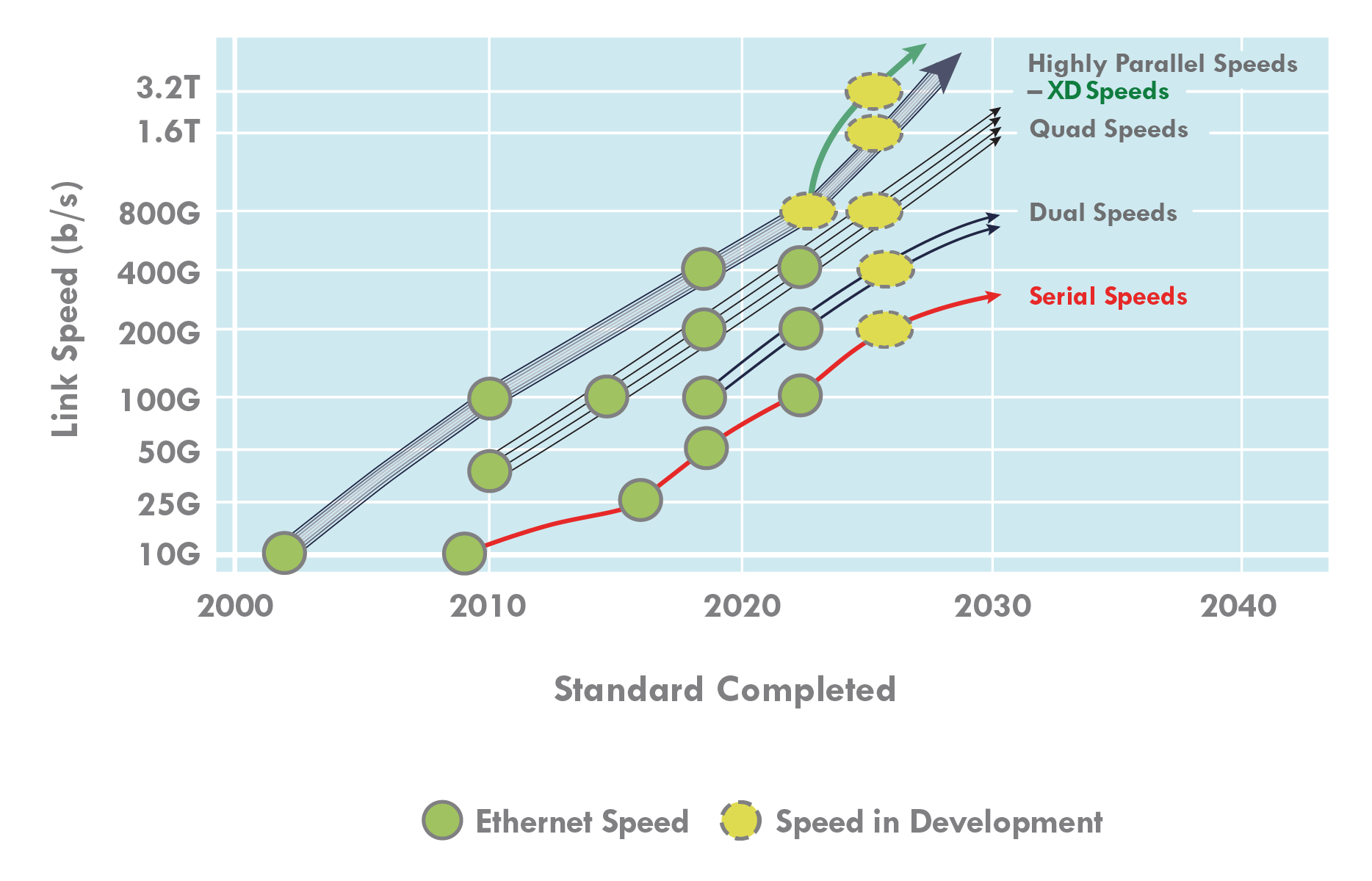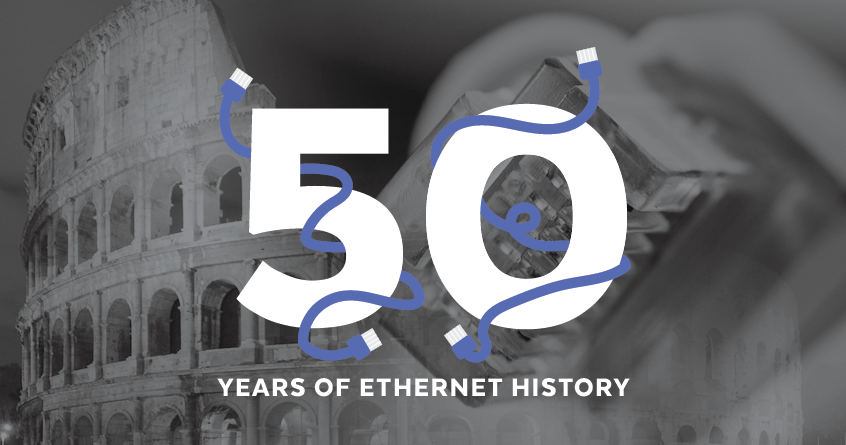When Was Ethernet Invented?
History always appears linear. The thousand-plus years of the Roman Empire1 can be conveniently divided into three periods. The Period of Kings covers the dawn of the Roman Republic all the way to the rise of Julius Caesar. Upon Caesar’s death, Rome entered its Imperial Period before disappearing in 476 AD. Within these three periods were years of civil war as Rome expanded and contracted, growing from a republic into an empire and descending into chaos during their inevitable decline. Like Rome, Ethernet history is far from linear. Plenty of technologies looked to corner the market on data communications, and Ethernet was not a clear favorite. Telephone lines and circuit switching would dominate the landscape as computer technology moved from mainframe to personal computer.
Mainframes controlled the computer market beginning in the mid-1960s. As more mainframes came online, the need for data communications between devices became a requirement. The telephone network had the infrastructure to deliver voice communications across distances, so it was a logical candidate for data transmission as well.
By 1968, competitors were offering high-speed modems (2400 to 4800 bps) and multiplexers for circuit switching. Even PBX systems were offering data and voice capabilities. Despite their limitations, modem sales would exceed $1 billion, and multiplexers would top half a billion before the shift to data-only connectivity in 1988.
Ethernet History: A Parallel Technology
While telecommunications companies continued to invest in circuit-switching solutions, other groups were not convinced that voice technology could meet the demands of data communications. Two groups, working separately, explored alternative hardware and software solutions that would ultimately become ethernet technology.
Cables
Bob Metcalf, working for Xerox, developed the first network cable in 1973. The coaxial cable carried one signal at a transmission speed of 10 megabits per second (Mbps). It was about half an inch in diameter and lacked the flexibility of today’s cabling. The initial models used packets to send and receive data. The process required a packet recipient to respond after receiving a message packet. If no response was received within a set parameter, the packet would be resent.
 Because the cabling had no regulatory capabilities, packets would collide, requiring retransmission of the data. In 1985, the Institute of Electrical and Electronics Engineers (IEEE) published its 802.3 standard for Carrier Sense Multiple Access with Collision Detection (CSMA/CD) protocol. The standard requires devices to check if a line is in use before transmitting a new packet. The IEEE would later publish standards for IBM’s competing token rings.
Because the cabling had no regulatory capabilities, packets would collide, requiring retransmission of the data. In 1985, the Institute of Electrical and Electronics Engineers (IEEE) published its 802.3 standard for Carrier Sense Multiple Access with Collision Detection (CSMA/CD) protocol. The standard requires devices to check if a line is in use before transmitting a new packet. The IEEE would later publish standards for IBM’s competing token rings.
Protocols
Ten years before the 802.3 CSMA/CD protocol was published, two scientists from the Department of Defense’s Advanced Research Projects Agency (ARPA) began looking at packet switching across radio networks. They eventually created the Transmission Control Protocol/Internet Protocol (TCP/IP) in the 1970s. They made the standard publicly available, while other packet-switching protocols remained proprietary.
The importance of TCP/IP to Ethernet history is two-fold. Its development focused on packet switching rather than circuit switching at a time when ethernet technology was still emerging. Because the standard was readily available, it became the protocol for the transport and network layers of the open systems interconnection (OSI) model in which ethernet technology occupies layers one and two.
Divergence
Not only were telecom companies trying to address the growing demand for data transmission, they were also struggling to adapt to the divestiture of AT&T. Many were focused on survival as the landscape changed. As a result, the second half of the 20th century saw telecommunications companies devote more resources to adapting circuit-switching technology to support data transmission. They leveraged their existing investments to maximize profits while meeting current needs. They were not terribly focused on meeting the demands of the future.
While telecommunications companies remained trapped in the present, researchers were already considering alternative data transmission solutions that did not rely on circuit technology. ARPA worked to develop a data communications network that would connect the Department of Defense and their contractors in the private sector. Xerox was exploring ways to connect laser printers to business networks. They remained unaffected by the chaos that followed the break up of AT&T. Xerox had the capacity to fuel a paradigm shift in data communications.
Ethernet History: Paradigm Shift
When the IEEE published its first 802.3 standard, it formalized the move from voice communications to data transmission. By the early 1990s, ethernet had outpaced IBM’s token ring as the local area network (LAN) technology of choice. It was more reliable and less expensive than telecom solutions. Its benefits encouraged businesses to move toward Ethernet networks.
Benefits of Ethernet
Ethernet technology provides organizations with:
- Low signal noise: Ethernet does not require the line conditioning of analog lines.
- Reliable data transfer: Ethernet experiences less interference for more consistent data delivery.
- Low cost: Running cables and installing switches and routers is less costly than building new phone lines.
- Faster transmission speeds: Twisted pair cables can send data faster with less interference.
While the technology was transformative, organizations helped fuel the paradigm shift.
IEEE
Beginning with its experimental standard in 1973, the IEEE has maintained working groups to support ongoing ethernet development. They have published over 50 standards since the 1985 publication and are in the process of developing standards for 400 and 800 Gbps. Their willingness to ensure backward compatibility has allowed companies to invest in technology without fear of immediate obsolescence.

Image Source: Ethernet Alliance
Ethernet Alliance
The Ethernet Alliance is the marketing arm of the IEEE. It is an industry consortium dedicated to advancing Ethernet technologies. Its membership works with the IEEE and end users to encourage the adoption of Ethernet technologies. They help bridge the gap between development and deployment to ensure the best possible outcomes.
Ethernet: The Future
The IEEE has launched a study group to look at high-speed data thresholds above 800 Gbps. IEEE’s standard for 400 Gbps is slated for release in 2024. The increased focus on sustainability makes Power over Ethernet (PoE) another avenue for Ethernet development. The growing demand for faster transmission speeds at longer distances while remaining environmentally responsible will fuel this technology’s growth. Versa Technology offers PoE products and solutions to meet the needs of today and to anticipate the demands of tomorrow.
Source:
- Roman Empire: www.mpm.edu/research-collections/anthropology/anthropology-collections-research/mediterranean-oil-lamps/roman-empire-brief-history

